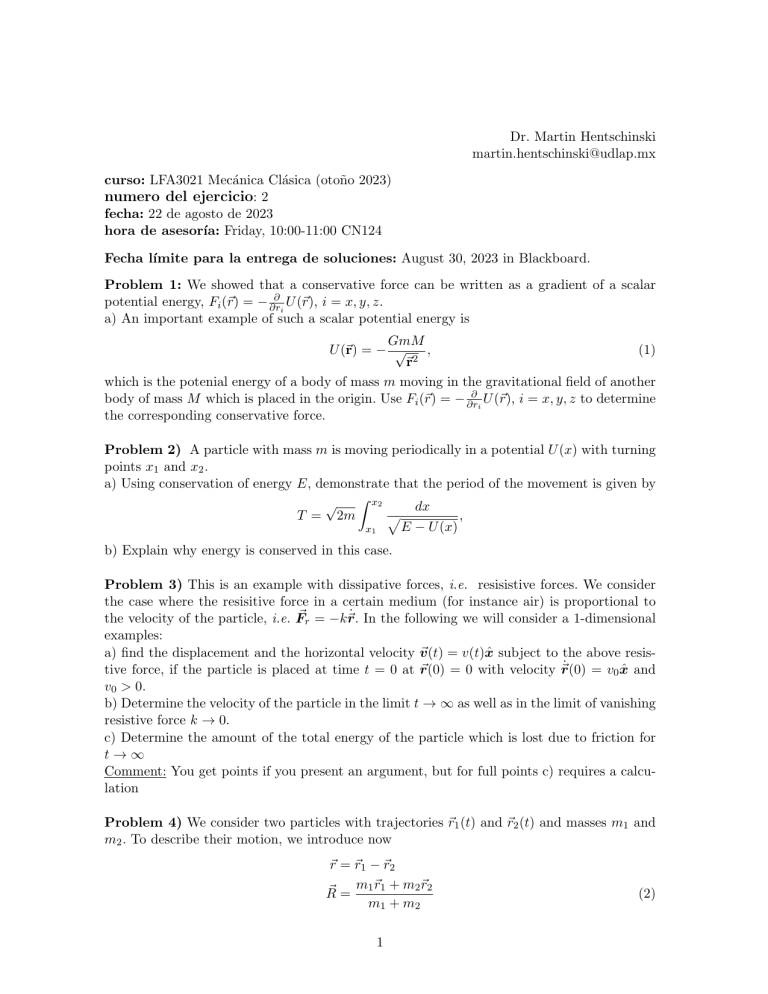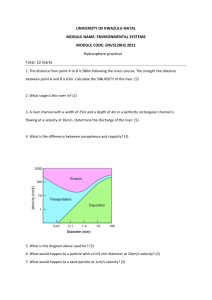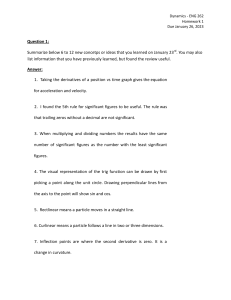
Dr. Martin Hentschinski martin.hentschinski@udlap.mx curso: LFA3021 Mecánica Clásica (otoño 2023) numero del ejercicio: 2 fecha: 22 de agosto de 2023 hora de asesorı́a: Friday, 10:00-11:00 CN124 Fecha lı́mite para la entrega de soluciones: August 30, 2023 in Blackboard. Problem 1: We showed that a conservative force can be written as a gradient of a scalar potential energy, Fi (~r) = − ∂r∂ i U (~r), i = x, y, z. a) An important example of such a scalar potential energy is GmM U (~r) = − √ , (1) ~r2 which is the potenial energy of a body of mass m moving in the gravitational field of another body of mass M which is placed in the origin. Use Fi (~r) = − ∂r∂ i U (~r), i = x, y, z to determine the corresponding conservative force. Problem 2) A particle with mass m is moving periodically in a potential U (x) with turning points x1 and x2 . a) Using conservation of energy E, demonstrate that the period of the movement is given by Z x2 √ dx p T = 2m , E − U (x) x1 b) Explain why energy is conserved in this case. Problem 3) This is an example with dissipative forces, i.e. resisistive forces. We consider the case where the resisitive force in a certain medium (for instance air) is proportional to the velocity of the particle, i.e. F~r = −k~r˙ . In the following we will consider a 1-dimensional examples: ~ (t) = v(t)x̂ subject to the above resisa) find the displacement and the horizontal velocity v ~ (0) = 0 with velocity ~r˙ (0) = v0 x̂ and tive force, if the particle is placed at time t = 0 at r v0 > 0. b) Determine the velocity of the particle in the limit t → ∞ as well as in the limit of vanishing resistive force k → 0. c) Determine the amount of the total energy of the particle which is lost due to friction for t→∞ Comment: You get points if you present an argument, but for full points c) requires a calculation Problem 4) We consider two particles with trajectories ~r1 (t) and ~r2 (t) and masses m1 and m2 . To describe their motion, we introduce now ~r = ~r1 − ~r2 ~ = m1~r1 + m2~r2 R m1 + m2 1 (2) a) Show that in absence of external forces, one has ~ ~ 0) + V ~0 (t − t0 ), R(t) = R(t (3) ~0 and position R(t ~ 0) with an arbitrary intial velocity V b) Show that µ~r¨ = F~12 , and determine the parameter µ (which is called the reduced mass) 2 (4)





